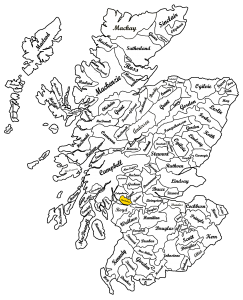Clan MacAulay Crest
|
|
CREST: A boot couped at the ankle and thereon a spur Proper MOTTO: Dulce periculm TRANSLATION: Danger is sweet VARIATIONS: McAulay |
 The MacAulays are believed to descend from one of the branches of the Siol Alpen, a confederation of kindred Highland clans. Interestingly, they share a common ancestry with the renowned Clan MacGregor. While the exact nature of their connection remains debated, the MacAulays and MacGregors became closely intertwined throughout history. The MacAulays are believed to descend from one of the branches of the Siol Alpen, a confederation of kindred Highland clans. Interestingly, they share a common ancestry with the renowned Clan MacGregor. While the exact nature of their connection remains debated, the MacAulays and MacGregors became closely intertwined throughout history.
One theory suggests that the MacAulays may have stemmed from Almhalidh, a younger son of the Earl of Lennox. However, the historical evidence surrounding this connection is not conclusive. Another notable figure mentioned is Maurice de Arncaple, who submitted to Edward I of England and is considered an ancestor of the Lairds of Ardincaple, which would later become the principal seat of the MacAulays. The close association between the MacAulays and the MacGregors led the former to participate in the feuds that plagued the latter. However, the MacAulays enjoyed some protection under the wing of the Earls of Lennox. This shielded them from the severe consequences faced by the MacGregors, who endured significant hardships during their turbulent history. The Bond of MacGregor and MacAulay: In 1591, a bond of manrent was forged between Macgregor of Glen Strae and the Laird of Ardincaple, solidifying the connection between the MacAulays and MacGregors. Although it is unclear whether the bond was based on direct descent or other factors, it signifies the intertwining fate of these clans. Decline and Change of Hands: Over time, the fortunes of the MacAulay clan dwindled, and the twelfth and last chief made the difficult decision to sell off their ancestral estates to the Campbells around 1767. This marked a significant turning point in their history, as their land and influence shifted into the hands of another prominent Scottish clan. Norse Descent and Notable Figures: Some MacAulays from Lewis claimed Norse descent, tracing their lineage back to Olaf. One particularly renowned chief was Donald Camm, known as Donald One-Eye. His strength and quarrelsome nature became the stuff of legend, earning him the Gaelic saying, “whoever is blind in an eye is pugnacious.” Donald Camm’s lineage eventually produced notable figures like Thomas Babington Macaulay, a nineteenth-century politician and historian. Thomas Babington Macaulay’s Legacy: Thomas Babington Macaulay, descendant of the MacAulays, made significant contributions to English history and literature. His acclaimed works, including the “History of England” and “Lays of Ancient Rome,” continue to be celebrated today. Despite his distinguished Highland ancestry, Macaulay rarely referenced his Scottish roots during his lifetime. He received numerous honors and was eventually raised to the peerage as Lord Macaulay. |
|
Citations:
- Descriptive catalogue of the clan tartans and family tartans of Scotland with a brief note on their antiquity: also roll of the landlords and Baillies of lands in the Highlands and isles, A.D. 1587: roll of the clans; badges of the clans, John Catto and Company, King Street, Toronto, Canada
- Scottish Clan & Family Encyclopedia”, by Collins, HarperCollins Publishers 1994

Purchase @ Redbubble
Purchase @ Amazon.com
Purchase @ Amazon.co.uk

